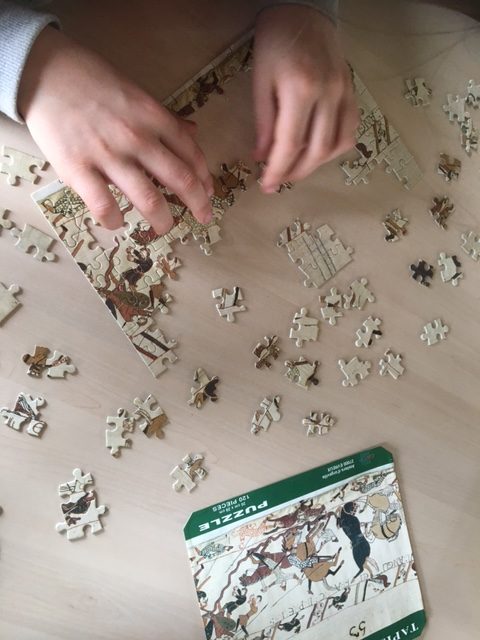
I stumbled across Reading Museum when googling Bayeux Tapestry resources. The depth of information provided makes the exhibits in the online museum perhaps more accessible than a visit to the actual museum would. Pupils can get up close and analyse details of each part of the tapestry, with no time limits, and no queues.

The website has such a wealth of information there is no need to add any additional resources to a homeschool study of the Bayeux Tapestry – everything you need to teach this topic is available here in one place.
Start by reading the History of Britain’s Bayeux together:


Use the text accompanying the tapestry sections (e.g. Harold is crowned King) to add a read-aloud element to the lesson, use the images of the tapestry as a guide for students to draw their own*, ask students to summarise what they’ve learnt into a paragraph explaining the events depicted in the tapestry.
We supplemented this lesson with worksheets from the School History website and rounded up the lesson completing a jigsaw puzzle of a section of the Bayeux Tapestry. Additional resources like this, more fun than school, are a good way to extend lessons in a way that keeps the learners’ mind focused on the lesson they’ve just completed, while letting their minds wander enough to process the information they’ve learnt: This leads to questions, filling in any topic learning gaps before the lesson is over.
Aside from the Bayeux Tapestry, Reading Museum’s blog offers content that can be used as lessons on a variety of subjects. A visit of Calvella, the ‘diary’ of a Roman living in what is now Silchester, would make a great addition to a Roman history project as a living history resource.
The Reading Museum blog is a collaboratively curated blog offering content curated by many other museums and the subject range is extensive.
From Berkshires Nightingales, again a fantastic living history resource for projects around healthcare, the NHS or Florence Nightingale; oral histories of events during the Second World War; and step-by-step guides through some of the more unusual, interesting work historians do and how they do it (like this virtual rebuilding of Reading Abbery as it would have looked in 1539), there are numerous resources to use as lessons in home-ed history classes.
*To extend Bayeux Tapestry lessons and to demonstrate how much work went into creating the tapestry, try asking students to draw the timeline of their own lives as a tapestry. Comic book templates can help students break down the story they want to tell into tapestry-style sections.



